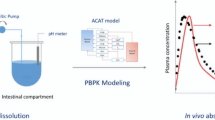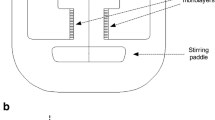Abstract
Purpose
Precipitation of weakly basic drugs in intestinal fluids can affect oral drug absorption. In this study, the implications of self-association of brivanib alaninate in acidic aqueous solution, leading to supersaturation at basic pH condition, on its solubility and oral absorption were investigated.
Methods
Self-association of brivanib alaninate was investigated by proton NMR spectroscopy, surface tension measurement, dynamic light scattering, isothermal titration calorimetry, and molecular modeling. Drug solubility was determined in various pH media, and its tendency to supersaturate upon pH shift was investigated in buffered and biorelevant aqueous solutions. Pharmacokinetic modeling of human oral drug absorption was utilized for parameter sensitivity analyses of input variables.
Results
Brivanib alaninate exhibited continuous, and pH- and concentration-dependent self-association. This phenomenon resulted in positive deviation of drug solubility at acidic pH and the formation of a stable supersaturated drug solution in pH-shift assays. Consistent with the supersaturation phenomenon observed in vitro, oral absorption simulations necessitated invoking long precipitation time in the intestine to successfully predict in vivo data.
Conclusions
Self-association of a weakly basic drug in acidic aqueous solution can increase its oral absorption by supersaturation and precipitation resistance at the intestinal pH. This consideration is important to the selection of parameters for oral absorption simulation.












Similar content being viewed by others
Abbreviations
- G+:
-
GastroPlus
- ITC:
-
Isothermal titration calorimetry
- NMR:
-
Nuclear magnetic resonance
- tppt :
-
Precipitation time
References
Dai WG. In vitro methods to assess drug precipitation. Int J Pharm. 2010;393:1–16.
Psachoulias D, Vertzoni M, Goumas K, Kalioras V, Beato S, Butler J, et al. Precipitation in and supersaturation of contents of the upper small intestine after administration of two weak bases to fasted adults. Pharm Res. 2011;28:3145–58.
Panakanti R, Narang AS. Impact of excipient interactions on drug bioavailability from solid dosage forms. Pharm Res. 2012;29:2639–59.
Siepmann J, Siepmann F, Florence AT. Factors influencing oral drug absorption and drug availability. In: Florence AT, Siepmann J, editors. Modern pharmaceutics. New York: Informa Healthcare; 2009.
Shono Y, Jantratid E, Dressman JB. Precipitation in the small intestine may play a more important role in the in vivo performance of poorly soluble weak bases in the fasted state: case example nelfinavir. Eur J Pharm Biopharm. 2011;79:349–56.
Kostewicz ES, Wunderlich M, Brauns U, Becker R, Bock T, Dressman JB. Predicting the precipitation of poorly soluble weak bases upon entry in the small intestine. J Pharm Pharmcol. 2010;56:43–51.
Higashino H, Hasegawa T, Yamamoto M, Matsui R, Masaoka Y, Kataoka M, Sakuma S, Yamashita S. In vitro-in vivo correlation of the effect of supersaturation on the intestinal absorption of BCS class 2 drugs. Mol Pharm 2014.
Gao P, Shi Y. Characterization of supersaturatable formulations for improved absorption of poorly soluble drugs. AAPS J. 2012;14:703–13.
Van Speybroeck M, Mellaerts R, Mols R, Thi TD, Martens JA, Van Humbeeck J, et al. Enhanced absorption of the poorly soluble drug fenofibrate by tuning its release rate from ordered mesoporous silica. Eur J Pharm Sci. 2010;41:623–30.
Miller MA, DiNunzio J, Matteucci ME, Ludher BS, Williams RO, Johnston KP. Flocculated amorphous itraconazole nanoparticles for enhanced in vitro supersaturation and in vivo bioavailability. Drug Dev Ind Pharm. 2012;38:557–70.
Beak I-H, Kim M-S. Improved supersaturation and oral absorption of dutasteride by amorphous solid dispersions. Chem Pharm Bull. 2012;60:1468–73.
Kennedy M, Hu J, Gao P, Li L, Ali-Reynolds A, Chal B, et al. Enhanced bioavailability of a poorly soluble VR1 antagonist using an amorphous solid dispersion approach: a case study. Mol Pharm. 2008;5:981–93.
Gao Y, Carr RA, Spence JK, Wang WW, Turner TM, Lipari JM, et al. A pH-Dilution method for estimation of biorelevant drug solubility along the gastrointestinal tract: application to physiologically based pharmacokinetic modeling. Mol Pharm. 2010;7:1516–26.
Takano R, Takata N, Saito R, Furumoto K, Higo S, Hayashi Y, et al. Quantitative analysis of the effect of supersaturation on in vivo drug absorption. Mol Pharm. 2010;7:1431–40.
Diaz-Padilla I, Siu LL. Brivanib alaninate for cancer. Expert Opin Investig Drugs. 2011;20:577–86.
Mathias NR, Xu Y, Patel D, Grass M, Caldwell B, Jager C, Mullin J, Hansen L, Crison J, Saari A, Gesenberg C, Morrison J, Vig B, Raghavan K. Assessing the risk of pH-dependent absorption for new molecular entities: a novel in vitro dissolution test, physicochemical analysis, and risk assessment strategy. Mol Pharm. (2013).
Narang AS, Yamniuk AP, Zhang L, Comezoglu SN, Bindra DS, Varia S, et al. Reversible and pH-dependent weak drug-excipient binding does not affect oral bioavailability of high dose drugs. J Pharm Pharmacol. 2012;64:553–65.
Bevernage J, Brouwers J, Brewster ME, Augustijns P. Evaluation of gastrointestinal drug supersaturation and precipitation: strategies and issues. Int J Pharm. 2013;453:25–35.
Patel DD, Joguparthi V, Wang Z, Anderson BD. Maintenance of supersaturation I: indomethacin crystal growth kinetic modeling using an online second-derivative ultraviolet spectroscopic method. J Pharm Sci. 2011;100:2623–41.
Carlert S, Akesson P, Jerndal G, Lindfors L, Lennernas H, Abrahamsson B. In vivo dog intestinal precipitation of mebendazole: a basic BCS class II drug. Mol Pharm. 2012;9:2903–11.
Mullin JW. Crystallization. Woburn: Butterworth-Heinemann; 2013.
Box KJ, Comer JE. Using measured pKa, LogP and solubility to investigate supersaturation and predict BCS class. Curr Drug Metab. 2008;9:869–78.
Box KJ, Comer JEA. Using measured pKa, LogP and solubility to investigate supersaturation and predict BCS class. Curr Drug Metab. 2008;9:869–78.
Dai W-G, Dong LC, Shi X, Nguyen J, Evans J, Xu Y, et al. Evaluation of drug precipitation of solubility-enhancing liquid formulations using milligram quantities of a new molecular entity (NME). J Pharm Sci. 2007;96:2957–69.
Carino SR, Sperry DC, Hawley M. Relative bioavailability estimation of carbamazepine crystal forms using an artificial stomach-duodenum model. J Pharm Sci. 2006;95:116–25.
Carlert S, Palsson A, Hanisch G, von Corswant C, Nilsson C, Lindfors L, et al. Predicting intestinal precipitation—a case example for a basic BCS class II drug. Pharm Res. 2010;27:2119–30.
Hansen NT, Kouskoumvekaki I, Jorgensen FS, Brunak S, Jonsdottir SO. Prediction of pH-dependent aqueous solubility of druglike molecules. J Chem Info Model. 2006;46:2601–9.
Mulder FA, Filatov M. NMR chemical shift data and ab initio shielding calculations: emerging tools for protein structure determination. Chem Soc Rev. 2010;39:578–90.
Harris RK. NMR studies of organic polymorphs and solvates. Analyst. 2006;131:351–73.
Kaucher MS, Lam YF, Pieraccini S, Gottarelli G, Davis JT. Using diffusion NMR to characterize guanosine self-association: insights into structure and mechanism. Chemistry. 2004;11:164–73.
Poon GMK. Explicit formulation of titration models for isothermal titration calorimetry. Anal Biochem. 2010;400:229–36.
Lovatt M, Cooper A, Camilleri P. Energetics of cyclodextrin-induced dissociation of insulin. Eur Biophys J. 1996;24:354–7.
Brouwers J, Brewster ME, Augustijns P. Supersaturating drug delivery systems: the answer to solubility-limited oral bioavailability? J Pharm Sci. 2009;98:2549–72.
ACKNOWLEDGMENTS AND DISCLOSURES
We thank Judy Lin for analytical method development and validation; Gabriella Siryj and Denette Murphy for powder X-ray diffraction; and BMS Exploratory Clinical and Translational Research (ECTR) team for human pharmacokinetic data.
Author information
Authors and Affiliations
Corresponding author
Rights and permissions
About this article
Cite this article
Narang, A.S., Badawy, S., Ye, Q. et al. Role of Self-Association and Supersaturation in Oral Absorption of a Poorly Soluble Weakly Basic Drug. Pharm Res 32, 2579–2594 (2015). https://doi.org/10.1007/s11095-015-1645-y
Received:
Accepted:
Published:
Issue Date:
DOI: https://doi.org/10.1007/s11095-015-1645-y




